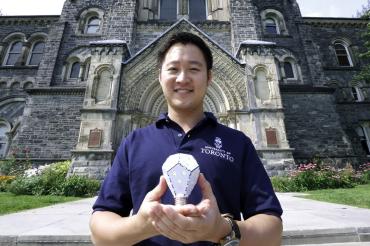So you want to build a startup? Canada’s top entrepreneurs offer U of T 10 tips

Published: March 28, 2017
Only half of new Canadian companies survive past five years, and only a tiny percentage become global success stories. Tiff Macklem, the dean of U of T's Rotman School of Management, has been thinking and writing a lot about how to improve these odds. He doesn’t believe Canadians are lacking in education or innovative ideas. But he does think we have a problem converting ideas into products and services that people – lots of people – want. Where is Canada’s answer to Spotify (first heard in Sweden) or Skype (founded in Estonia)?
“The crux of our problem is commercialization and scale,” Macklem says.
In his view, what Canadian startups are missing is great business judgment, which, as he points out, is not easy to acquire: “A new venture cannot simply go downtown and purchase a unit of business judgment,” he says.
To address this, the U of T Entrepreneurship network of incubators, accelerators and programs, including at Rotman, are connecting fledgling companies with expert mentors to provide the kind of hands-on advice they’ll need to get through those perilous first few years – and, with any luck, eventually compete on a global scale.
Here are facts about U of T startups:
- Between 2013 and 2015, researchers at U of T and its partner hospitals created an average of one new invention every 21 hours and filed a new patent application an average of about once every five days
- About three quarters of U of T inventions are co-developed by students or post-docs
- U of T offers 68 courses covering various aspects of entrepreneurship.
For Entrepreneurship @ U of T Week, some of Canada’s top entrepreneurs share lessons they learned on the path to success.
Learn more about Entrepreneurship@UofT Week
No. 1: “As an entrepreneur, the best product you can build is yourself”
 Allen Lau is the CEO and co-founder of Wattpad, an online story-sharing community with 45 million monthly users.
Allen Lau is the CEO and co-founder of Wattpad, an online story-sharing community with 45 million monthly users.
In the early days of Wattpad, U of T alumnus Lau had everything under control. He and co-founder Ivan Yuen had come up with the idea, developed the technology and written the code. They now waited for readers and writers to flock to it and advertising revenue to pour in. It took a while.
That first year, 2006, Wattpad had barely a thousand users. Over the next couple of years, however, interest grew and so did the company. But Lau discovered that while he was proficient on the technology side, in other skills – marketing and publicity, raising capital – he was less competent.
Or as he puts it: “I was horrible! I realized that if I wanted to scale the company, I had to scale myself,” in other words, quickly acquire new skills with each phase of the company’s growth. When Wattpad needed more employees, Lau suddenly had to learn through trial and error how to hire people, then how to delegate. When the company required more than one engineer or marketer, he needed to hire team leaders, which meant he had to become a leader himself.
“And that’s a very different skill set.”
Approaching investors required different expertise again. “When I approached 40 potential investors, 39 said no,” Lau says. “It wasn’t because the idea wasn’t good but because I failed to communicate it.” With practice, his pitch kept improving. As Wattpad grew, Lau’s job shifted to communications and strategy. Now with a staff of 130 and with 45 million monthly users (even CanLit star Margaret Atwood has published new work on the site), Wattpad has moved toward becoming a global entertainment company, partnering to co-produce original Wattpad stories for movies and TV.
“It’s almost like every year I’m getting a new job, which can be very daunting if you’re not good at self-learning,” Lau says.
No. 2: “Find a business idea you feel passionate about”
 Cynthia Goh is the academic director of University of Toronto Entrepreneurship and the founding director of U of T’s Impact Centre, a business incubator.
Cynthia Goh is the academic director of University of Toronto Entrepreneurship and the founding director of U of T’s Impact Centre, a business incubator.
A serial entrepreneur herself, she has assisted at the births of 136 startups. From her perspective as an entrepreneur and a mentor, Goh looks for a certain special enthusiasm as a major predictor of success.
“The most important thing is passion. Not for making money, but for the idea.”
No matter how awesome your business concept, she says, if you don’t believe in it strongly enough, you’ll give up at the first obstacle.
“Being an entrepreneur can be a tough road so you’ve got to be fuelled by passion.”
She cites a recent U of T success story. Adrenalease sells performance clothing that realigns posture, and Goh credits the infectious enthusiasm of founder and president Noureddin Chahrour, a kinesiology grad, for the company’s early achievements.
“He is obsessed with muscles, and how they function,” Goh says.
In 2015, that passion helped persuade four of the five venture capitalists on CBC-TV’s Dragons’ Den to offer him deals.
No. 3: “Get an advanced degree, and set audacious goals”
 Kristjan Sigurdson is the associate director of the Creative Destruction Lab and a PhD candidate at the Rotman School of Management. Launched in 2012, the Creative Destruction Lab’s nine-month program pairs startup founders with experienced technology entrepreneurs and investors. The program, based at Rotman, is designed for early-stage, science-based technology companies.
Kristjan Sigurdson is the associate director of the Creative Destruction Lab and a PhD candidate at the Rotman School of Management. Launched in 2012, the Creative Destruction Lab’s nine-month program pairs startup founders with experienced technology entrepreneurs and investors. The program, based at Rotman, is designed for early-stage, science-based technology companies.
Having an advanced degree and setting audacious goals for your startup gives you three important advantages, says Sigurdson. First, your deep expertise gives you the credibility to go into a meeting with investors, teach them something about the future of science or technology and convince them that you can meet your goals.
“If you do that successfully, they’re probably going to want to take another meeting with you.”
Second, it enables you to hire others with deep expertise in your field. If you have an MBA but no experience in quantum physics, it’s difficult to recruit someone with a PhD in quantum physics, Sigurdson observes.
“It’s easier to learn how to run a company than it is to become a leading expert in a field.”
Third, when your company trajectory invariably changes – because of an obstacle you couldn’t anticipate – it’s easier to adapt if you have a deep well of knowledge to draw from and a network
of like-minded experts to help you. Sigurdson offers the example of a founder working with the Creative Destruction Lab whose audacious goal is to build a next-generation quantum computer that uses off-the-shelf components and works at room temperature (most quantum computing research is conducted at low temperatures). The founder has a PhD in quantum information theory and a large network of collaborators in multiple countries.
“If he just had an undergraduate degree in physics and a faculty adviser – or an MBA and a business plan – he wouldn’t have lasted long in a room with investors,” says Sigurdson. “And the audacious goal will help him to attract the top-notch talent he’ll need to succeed.”
No. 4: “Accept that sometimes you’ll be unlucky, and move on”
 Daniel Debow is a serial entrepreneur and an adjunct professor of law at U of T. A member of the teams that founded Workbrain and Rypple, Debow and his partners sold Rypple to Salesforce in 2012, but Debow stayed on for three years to oversee emerging technologies. He is currently building a new startup, Helpful.com.
Daniel Debow is a serial entrepreneur and an adjunct professor of law at U of T. A member of the teams that founded Workbrain and Rypple, Debow and his partners sold Rypple to Salesforce in 2012, but Debow stayed on for three years to oversee emerging technologies. He is currently building a new startup, Helpful.com.
“One of the most important lessons I learned,” says Debow, “was from David Ossip (the founder of Workbrain and a U of T Scarborough alumnus).
It was the power of the word ‘unlucky.’”
Early in his career, Debow collaborated with Ossip on Workbrain – a workforce-management software system for companies with a large number of hourly staff.
After 18 months of development, they’d finally landed British Airways as a customer and Ossip was planning to attend an airline conference in order to pitch new clients. But the day he was scheduled to travel was Sept. 11, 2001. He never got to the conference, and the terrorist attacks sent the aviation industry into a years-long tailspin. No one was buying new systems.
“David just said, ‘unlucky,’ and we went off and built another plan.” The point, Debow says, is that entrepreneurs like Ossip don’t dwell on unforeseen disasters, nor do they spend time obsessing
over what went wrong.
“I learned you have to take the world as it is, not as you wish it to be,” reflects Debow. “Stuff happens. You have to respond.”
No. 5: “Spend at least one day a week cultivating relationships with investors”
 Anthony Lacavera is the founder and chairman of the Globalive Group. He also founded Wind Mobile, which was sold in 2015 to Shaw Communications for $1.6 billion.
Anthony Lacavera is the founder and chairman of the Globalive Group. He also founded Wind Mobile, which was sold in 2015 to Shaw Communications for $1.6 billion.
“It doesn’t matter how good your technology or your team is,” says Lacavera, a U of T alumnus who in the past 20 years has founded a dozen startups – mostly in telecommunications and software.
“If you have no capital, someone with technology or a team that’s not as good but who has capital will beat you 10 times out of 10.”
Lacavera advises entrepreneurs to continually build relationships with investors by talking to their existing ones, asking for referrals to new ones and cold-calling potential ones. He’s done that for years, and that’s why he was able to raise $700 million to start Wind Mobile in 2008.
“Wind succeeded not because I’m a great salesperson or had an unbelievable business. It’s because I was able to raise the capital,” he says.
No. 6: “Test out your ideas in the real world. Don’t get caught in analysis paralysis”
 Toni Allen is the founding partner of R3VE Business Design Inc., which specializes in user experience and business innovation.
Toni Allen is the founding partner of R3VE Business Design Inc., which specializes in user experience and business innovation.
For entrepreneurs pushing themselves to create a unique product, there’s always a powerful temptation to devote too much time to perfecting a solution, and not enough to getting it out the door.
The lesson, according to Allen, a U of T Mississauga alumna: “You lose opportunities. You have to get out there and test your ideas.”
Allen’s five-year-old firm, R3VE, provides user experience, service design and business model innovation to large corporate clients, including banks. Early on, Allen recounts, she was developing a product geared at a specific retailer. Allen had identified the right person to pitch and had created a proposal but waited too long before making her approach, and the ship sailed.
This habit of mind – overplanning – came from her days working in a large bank where she’d sought to convince her colleagues that they needed to focus on the way design and technology overlap in the delivery of financial services. In that setting, she recalls, “I didn’t know how to pitch ideas and make a business case.”
Those early instincts about the opportunity for leveraging design thinking and user experience principles in the financial services market proved to be correct and provided the impetus for R3VE. But her insights only became a viable business when she got herself in front of customers: “When you have an idea, you need to try it and test it. Don’t get caught in analysis paralysis.”
No. 7: “Choose your business partners carefully and communicate openly and honestly with each other”
 Sonya Amin is the director, client services, of AXS Studio, which she co-founded in 2004 with fellow U of T alumni Eddy Xuan and Jason Sharpe. With 15 employees at its downtown Toronto office, the company creates visuals for teaching science and life sciences, including illustrations, animations and interactive applications.
Sonya Amin is the director, client services, of AXS Studio, which she co-founded in 2004 with fellow U of T alumni Eddy Xuan and Jason Sharpe. With 15 employees at its downtown Toronto office, the company creates visuals for teaching science and life sciences, including illustrations, animations and interactive applications.
In hindsight, says Amin, she was lucky. She and her two business partners share the same goals for AXS Studio and their individual strengths complement each other. But they didn’t spend much time planning it that way, she admits.
“We went into it as a dream that three classmates shared when they were in school.”
What they did have was trust in each other – crucial for a relationship that, like a marriage, will be sorely tested at times, says Amin.
“If you don’t trust your partner with your life then you shouldn’t be getting into business together.”
Amin says the ability to speak openly and honestly with each other is paramount – a lesson the AXS Studio founders learned when it became apparent that they were not aligned on how they
defined growth for their company.
“We had to have a candid conversation and managed to get to the heart of the matter: AXS’s goals needed to be aligned with our rarely discussed personal goals.”
This realization prompted the partners to emphasize open and clear communication with their employees as well.
“When we hear of anyone talking vaguely, or if we suspect that people might be working at cross-purposes, we stop and look at it more closely,” she says. “This has helped in lots of different
areas from human resources to day-today production.”
Amin credits the U of T biomedical communications program with enabling students like her with an aptitude for both art and science, to make a career out of their dual loves. The program is
also very practical, she says, adding that staff recommended clients when she and her co-founders launched AXS Studio.
“They’re amazingly supportive of their students.”
No. 8: “Don’t mistake expressions of interest from potential customers as evidence that you’ve tapped into a viable market”
 Karl Martin is the co-founder and chief technology officer for Nymi, a tech company that allows users to gain access to their devices by wearing a wristband that detects their unique heart pattern.
Karl Martin is the co-founder and chief technology officer for Nymi, a tech company that allows users to gain access to their devices by wearing a wristband that detects their unique heart pattern.
Throughout 2015, executives for Nymi, a Toronto firm that’s developed a wristband security device, were doing the rounds, talking up their technology to potential customers. At meeting after meeting, recalls Martin, they’d hear the same thing: we love your technology, which allows wearers to log onto a range of computer devices by detecting unique heartbeat patterns, but we need more features and capabilities.
As the U of T alumnus recounts, he and his team were energized by all that interest, but they had big challenges taking the next step, which was to really figure out how to hone the positioning of their device to fit the needs of specific users.
Indeed, says Martin, it was only after Nymi started getting orders from pharmaceutical manufacturers that he realized what the stumbling block had been. In ordinary office settings, there was no way to compel employees to wear the wristbands. But in the controlled environment of a manufacturing facility, where workers are required to wear sterile and protective gear, that problem evaporated. And so did the sales roadblock.
The lesson, Martin observes, is that many entrepreneurs whose startups are transitioning from research and development to marketing glom onto the slightest spark of interest from potential customers as evidence that the firm is ready to lift off.
“Recognize that you usually think you have a product-market fit before you actually do.”
No. 9: “Be prepared to act quickly when faced with a big challenge”
 Kim Shannon is the founder, president and co-chief investment officer of Sionna Investment Managers, which has assets of $5 billion.
Kim Shannon is the founder, president and co-chief investment officer of Sionna Investment Managers, which has assets of $5 billion.
As Sionna Investment Managers has grown over the past 15 years, says Shannon, so has her need to be adaptable.
“You have to keep nimble as issues emerge because you never know what’s around the corner.”
One of the most significant challenges happened when her biggest client – a fund company representing 90 per cent of her business – asked her to lower her rates for them.
“We fired them,” Shannon says. A risky move indeed, but she knew that working with a difficult or controlling client didn’t fit with her long-term goals for the company.
It was a tense time but a brief one. Soon other interested companies began approaching Sionna.
“Before, those companies hadn’t wanted to be secondary clients,” she explains. “But once the big one was gone, we had people coming to us. They actually admired us for what we’d done.”
Sionna quickly diversified its client base and expanded the business. Ultimately, Shannon mended relations with the big client, and she now includes the company’s stock in Sionna’s portfolios.
While she was a student at U of T, Shannon served on student council, launched a women’s newspaper and started a peer-counselling program. She credits her volunteer activities for building
her skills in organization, leadership and collaboration.
“If you have volunteer experience, your career progress will be much faster,” she says. “Many successful people I see in business were once student leaders.”
No. 10: “Skate to where the puck is going”
 Michael Serbinis is the the founder and CEO of League, a digital health insurance platform. Previously, he co-founded Kobo, the e-reader service.
Michael Serbinis is the the founder and CEO of League, a digital health insurance platform. Previously, he co-founded Kobo, the e-reader service.
When Serbinis thinks about the long-term goals for his company, he envisions a trillion-dollar global market.
“Our goal,” he says “is to disrupt an age-old insurance industry with a new philosophy focused on empowering people to be healthy every day.”
As the head of a startup, though, Serbinis needs to balance his long-term ambitions with the smaller challenges he and his team face every day. As with all startups, League staff are building product, hiring and firing staff, landing the next customer, making payroll, meeting investors and more.
“It never stops, and it is pretty easy to get caught up in the short term,” says Serbinis.
“But you have to keep your eye on the prize. I do that by having very clear long-term objectives that I repeat over and over to myself and the team. We regularly review our plans and brainstorm: What’s it going to take to meet our long-term goals? What are the risks, and what are the opportunities?”
Serbinis says it’s important to make bets on the future.
“As CEO, you cannot be consumed by today. You need to be putting in place the infrastructure that is going to help you scale. You need to be setting up enablers that will help your team three, six, nine and 12 months out.”
Reflecting on his time as a grad student at U of T, Serbinis says his supervisor was Joseph Paradi, an engineer-turned-entrepreneur who built Dataline, one of the first digital stock-quote platforms in Canada.
“He was my mentor at a time when I had no money, and I didn’t know what being an entrepreneur meant or how to lead or manage teams,” says Serbinis. “He inspired me, and we still keep in touch to this day.”
Watch for this story and others about entrepreneurship in the Spring 2017 issue of U of T Magazine.
(Daniel Debow's photo was taken by Jordana Huber, Kim Shannon's photo was taken by Gordon Hawkins and Michael Serbinis photo courtesy of the League)



